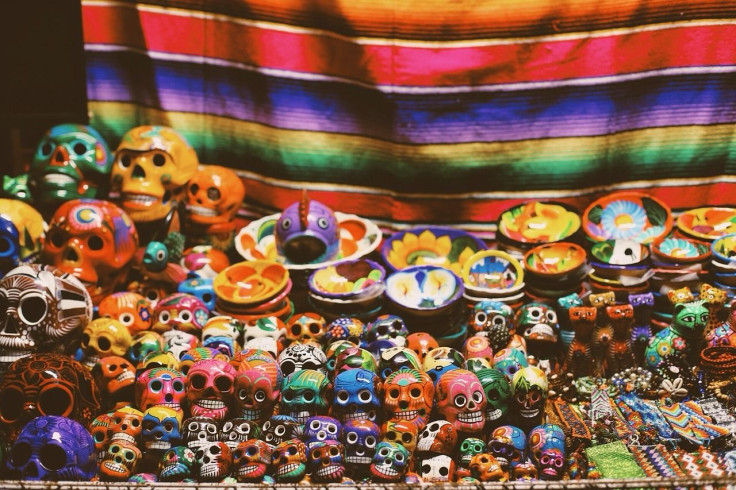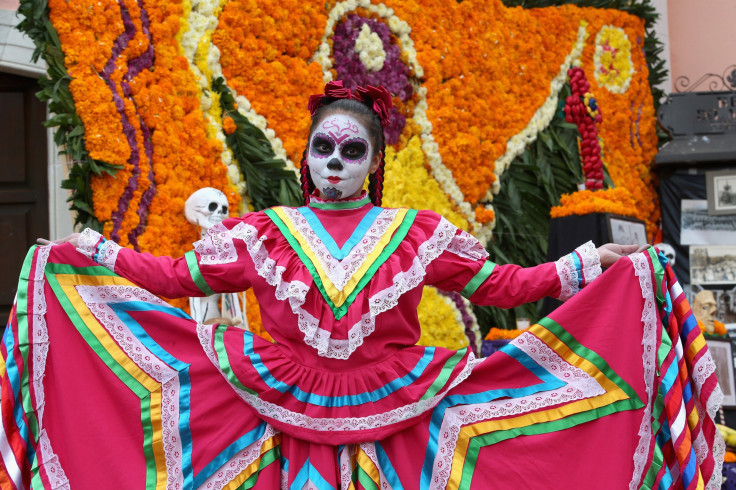Dia De Los Muertos, Or 'Day Of The Dead,' Helps Families Cope With Grief Through Sugar Skulls, Food, And Drinks

You’ve most likely heard of it but probably don’t know much about it. The Mexican holiday Día de los Muertos (Day of the Dead) is commonly known for its colorful, grinning sugar skulls — a symbol of the dead — seen in art and fashion. But the two-day holiday, which falls on Nov. 1-2, is more than that. Over the course of two days, friends and family congregate in cemeteries to remember, pray for, and celebrate the deceased with food and drinks. While it may seem strange to celebrate death, the festivities can actually help some people deal with the effects of grief.
Day of the Dead: The Origins
The Day of the Dead goes back to thousands of years before the Spanish conquest, when various ethnic groups in the region, including Aztecs, Mayans, and Toltecs, commemorated the deceased at different times of the year. They’d dedicate certain months to honoring the death of children, while other months were designated to honor adults.
The celebrations are based on the indigenous Mexican beliefs that the soul is eternal and can therefore travel back and forth between this world and the afterlife. They believed the departed would return during the festivities, which were full of music and dancing rather than mourning, to receive gifts.
The Sugar Skull: A Departed Soul
Skulls typically depict a dark and macabre atmosphere. But on the Day of the Dead, the skull — called La Catrina — symbolizes the departed souls as well as the ability to “laugh at death itself,” Kriss A. Kevorkian, a thanatologist and self-proclaimed “deaducator” in the field of end-of-life care for over 20 years, told Medical Daily.
The colorful, whimsical skulls were first introduced in the early 1900s by Mexican artist Jose Guadalupe Posada, who would use them in his art, which served as political and cultural critiques of the upper classes during the 35-year reign of Porfirio Diaz. Since Posada’s death, however, his skulls have become associated with the Day of the Dead. Children and their parents often visit fairs where they can buy skulls made of candy — hence the term “sugar skull” — and subsequently give them to friends and family as gifts.

Traditionally, the names of the deceased are written on the skulls’ foreheads before being placed on the ofrenda, or altar, in the family’s home. A photo of the person who died accompanies the skull, along with Cempazuchitl — a marigold flower native to Mexico — candles, food, beverages, and clothes. This collection of items is often a combination of the dead’s favorite things and are given as gifts.
Tracee Dunblazier, a spiritual empath and certified grief counselor based in Los Angeles, Calif., celebrates Day of the Dead every year. She sees the holiday as recognition that “our loved ones exist on another “plane” and says we have “access to them when the spiritual veil is thin around the fall equinox.” For those who grieve, then, the Day of the Dead offers a way to mourn by creating a new frame of thought around death. It allows us to relate to those who are no longer physically with us.
The Cemetery: A Place of Celebration, Not Mourning
Families start preparing for the return of their loved ones weeks before the Day of the Dead. At home, families set up a table top exclusively used for the altar, or they build one from a stack of crates, and lastly, drape cloth over it to arrange the ofrendas (offerings), including Cempazuchitl, candles, incense, photos of the deceased, pan de muerto, sugar skulls, among many others. The deceased are believed to absorb the aroma and the energy of the foods to nourish and replenish their spirits.
The ceremony is different from typical funerals or memorial services in the United States. Prior to the celebration, the gravesites of the deceased are cleaned and adorned with marigold flowers and candles, along with toys for the deceased children, and bottles of liquor for the deceased adults. On Day of the Dead, well after dark, people visit the cemetery where their loved ones are buried. Visitors sit on blankets next to the tombs to eat the favorite food of their loved ones throughout the night.

These ceremonies allow people to establish and celebrate the connection between the living and the dead. After all, as Kevorkian, says, death is a part of life. “The celebration acknowledges the physical loss of a loved one, but the relationship doesn't have to be severed as other cultures seem to insist upon through sayings such as, ‘Get over it’ or ‘She was old,’ which only causes more difficulty for the person in grief,” she said.
A New Way Of Mourning?
The morbid and daunting view of cemeteries in the U.S. has changed, and it’s not only because of traditions like Day of the Dead. A relatively new phenomenon called graving has emerged; it involves visiting grave sites — either for fun or to find information. Some people, for example, are interested in finding the graves of 1950s Hollywood stars while others are genealogical gravers, who try to complete their family tree with the help of information from headstones.
Gravers obtain this information from FindAGrave.com , a database of more than 138 million burial records. Gravers simply enter the deceased’s name, biographical details, and burial location. Cemetery, date of birth and death, and even “claim to fame” are also available search filters on the database. And users can leave comments and virtual flowers, or upload portraits or headstone photos.
Russell Friedman, executive director of The Grief Recovery Institute Educational Foundation in Sherman Oaks, Calif., believes visiting these graves can have a positive effect on people and, to a much lesser degree, a negative one. “A visit to the grave can help us look at the relationship in a way that helps us discover some of the things that we wish had been ‘different, better, or more,’” he told Medical Daily in an email.

But awareness of these situations doesn’t equate to an understanding of what happened, Friedman said — after all, there are multiple sides to every issue. For this reason, opening a dialogue with loved ones can help us connect the dots, especially if we have revelations while visiting the grave.
Graving may go against the norm, but it also provides a 21st century approach to how we should look at death — and cemeteries, for that matter. Those who cannot bring themselves to physically visit a gravesite, for example, can do so online with Find a Grave, and it’ll be on their own terms. While this may not be a tradition like Day of the Dead, it is an alternative option to commemorate the dead.
As humans, we're conditioned to fear death because it is seen as our destiny, but what if we were to view death as a celebration, like Day of the Dead?
The holiday fuses the realities of life and death, encouraging families of the deceased to embrace the passing of a loved one with music, food and drinks. It provides meaning to human existence and gives those who celebrate it an answer to what happens next — therefore, in a way, it’s life after death. Despite its name, Day of the Dead is truly a celebration of life.
Published by Medicaldaily.com



























